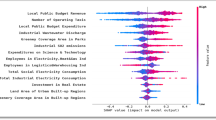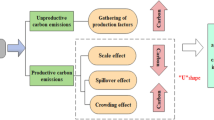Abstract
Globally, urban has been the major contributor to greenhouse gas (GHG) emissions and thus plays an increasingly important role in its efforts to reduce CO2 emissions. However, quantifying city-level CO2 emissions is generally a difficult task due to lacking or lower quality of energy-related statistics data, especially for some underdeveloped areas. To address this issue, this study used a set of open access data and machine learning methods to estimate and predict city-level CO2 emissions across China. Two feature selection technologies including Recursive Feature Elimination and Boruta were used to extract the important critical variables and input parameters for modeling CO2 emissions. Finally, 18 out of 31 predictor variables were selected to establish prediction models of CO2 emissions. We found that the statistical indicators of urban environment pollution (such as industrial SO2 and dust emissions per capita) are the most important variables for predicting the city-level CO2 emissions in China. The XGBoost models obtained the highest estimation accuracy with R2 > 0.98 and lower relative error (about 0.8%) than other methods. The CO2 emissions predictive accuracy can be improved modestly by combing geospatial and meteorological interpolation predictor variables (e.g., DEM, annual average precipitation, and air temperature). We also observed an S-shape relationship between urban CO2 emissions per capita and urban economic growth when the rest variables were held constant, rather than a U-shaped one. The findings presented herein provide a first proof of concept that easily available socioeconomic statistical records and geospatial data at urban areas have the potential to accurately predict city-level CO2 emissions with the aid of machine learning algorithms. Our approach can be used to generate carbon footprint maps frequently for the undeveloped regions with scarce detailed energy-related statistical data, to assist policy-makers in designing specific measures of reducing and allocating carbon emissions reduction goal.







Similar content being viewed by others
Data availability
Data are available from the authors upon request.
References
Alam S, Kumar A, Dawes L (2020) Roughness optimization of road networks: an option for carbon emission reduction by 2030. J Transp Eng B Pavements 146(4):04020062. https://doi.org/10.1061/JPEODX.0000203
Baiocchi G, Creutzig F, Minx J, Pichler P (2015) A spatial typology of human settlements and their CO2 emissions in England. Glob Environ Chang 34:13–21. https://doi.org/10.1016/j.gloenvcha.2015.06.001
Ballantyne AG, Wibeck V, Neset TS (2016) Images of climate change–a pilot study of young people’s perceptions of ICT-based climate visualization. Clim Chang 134:73–85. https://doi.org/10.1007/s10584-015-1533-9
Bayar Y, Diaconu L, Maxim A (2020) Financial development and CO2 emissions in post-transition European Union countries. Sustainability 12:2640. https://doi.org/10.3390/su12072640
Breiman L (2001) Random forests. Mach Learn 45:5–32. https://doi.org/10.1023/A:1010933404324
Chen T, Guestrin C (2016) XGBoost: a scalable tree boosting system. ArXiv e-prints785–794
Chen X, Zhang S, Ruan SM (2021) Polycentric structure and carbon dioxide emissions: Empirical analysis from provincial data in China. J Clean Prod 278:123411. https://doi.org/10.1016/j.jclepro.2020.123411
China City Statistical Yearbook (2011) China Statistical Press, Beijing, China (in Chinese)
Cortes C, Vapnik V (1995) Support-vector networks. Mach Learn 20:273–297. https://doi.org/10.1007/BF00994018
Dhakal S (2009) Urban energy use and carbon emissions from cities in China and policy implications. Energ Policy 37:4208–4219. https://doi.org/10.1016/j.enpol.2009.05.020
Fan JL, Wang XK, Wu LF, Zhou HM, Zhang FC, Yu X, Lu XH, Xiang YZ (2018) Comparison of support vector machine and extreme gradient boosting for predicting daily global solar radiation using temperature and precipitation in humid subtropical climates: a case study in China. Energy Convers Manag 164:102–111. https://doi.org/10.1016/j.rser.2018.10.018
Fang DB, Zhang XL, Yu Q, Jin TC, Tian L (2018) A novel method for carbon dioxide emission forecasting based on improved Gaussian processes regression. J Clean Prod 173:143–150. https://doi.org/10.1016/j.jclepro.2017.05.102
Friedman JH (2001) Greedy function approximation: a gradient boosting machine. Ann Stat 29:1189–1232. https://doi.org/10.1214/aos/1013203451
Friedman JH (2002) Stochastic gradient boosting. Comput Stat Data Anal 38:367–378. https://doi.org/10.1016/S0167-9473(01)00065-2
Fujii H, Iwata K, Chapman A, Kagawa S, Managi S (2018) An analysis of urban environmental Kuznets curve of CO2 emissions: empirical analysis of 276 global metropolitan areas. Appl Energy 228:1561–1568. https://doi.org/10.1016/j.apenergy.2018.06.158
Guyon I, Weston J, Barnhill S, Vapnik V (2002) Gene selection for cancer classification using support vector machines. Mach Learn 46:389–422. https://doi.org/10.1023/A:1012487302797
Hammond GP, Norman JB (2012) Decomposition analysis of energy-related carbon emission from UK manufacturing. Energy 41(1):220–227. https://doi.org/10.1016/j.energy.2011.06.035
Han F, Xie R, Lu Y, Fang JY, Liu Y (2018) The effects of urban agglomeration economies on carbon emissions: evidence from Chinese cities. J Clean Prod 172:1096–1110. https://doi.org/10.1016/j.jclepro.2017.09.273
He DQ, Meng F, Wang MQ, He KB (2011) Impacts of urban transportation mode split on CO2 emissions in Jinan. China. Energies 4:685–699. https://doi.org/10.3390/en4040685
Heun MK, Carbajales-Dale M, Haney BR (2015) Beyond GDP, lectures notes in energy. Springer, Cham. https://doi.org/10.1007/978-3-319-12820-7
Hu M, Li R, You W, Liu YB, Lee CC (2020) Spatiotemporal evolution of decoupling and driving forces of CO2 emissions on economic growth along the Belt and Road. J Clean Prod 277:123272. https://doi.org/10.1016/j.jclepro.2020.123272
Huang YS, Shen L, Liu H (2019) Grey relational analysis, principal component analysis and forecasting of carbon emissions based on long short-term memory in China. J Clean Prod 209:415–423. https://doi.org/10.1016/j.jclepro.2018.10.128
IPCC (2014) Climate change 2014: synthesis report. Contribution of working groups I, II, III to the fifth assessment report of the intergovernmental panel on climate change. IPCC, Geneva, p 151
Jebli MB, Youssef SB, Ozturk I (2016) Testing environmental Kuznets curve hypothesis: the role of renewable and non-renewable energy consumption and trade in OECD countries. Ecol Indic 60:824–831. https://doi.org/10.1016/j.ecolind.2015.08.031
Jeong K, Hong T, Kim J (2018) Development of a CO2 emission benchmark for achieving the national CO2 emission reduction target by 2030. Energy Build 158:86–94. https://doi.org/10.1016/j.enbuild.2017.10.015
Krantz J, Larsson J, Lu W, Olofsson T (2015) Assessing embodied energy and greenhouse gas emissions in infrastructure projects. Buildings 5(4):1156–1170. https://doi.org/10.3390/buildings5041156
Kunnas, Jan, Myllyntaus (2009) Postponed leap in carbon dioxide emissions: the impact of energy efficiency, fuel choices and industrial structure on the Finnish Energy Economy, 1800–2005. Glob Environ 2(3):154–189. https://doi.org/10.3197/ge.2009.020307
Kursa MB, Rudnicki WR (2010) Feature selection with the Boruta package. J Stat Softw 36:1–13. https://doi.org/10.18637/jss.v036.i11
Li Y, Wei YG, Dong Z (2020) Will China achieve its ambitious goal? — forecasting the CO2 emission intensity of China towards 2030. Energies 13:2924. https://doi.org/10.3390/en13112924
Lin BQ, Wang M (2020) The role of socio-economic factors in China’s CO2 emissions from production activities. Sustain Prod Consump. https://doi.org/10.1016/j.spc.2020.10.029
Lin DT, Zhang LY, Chen C, Lin YY, Wang JK, Qiu RZ, Hu XS (2019) Understanding driving patterns of carbon emissions from the transport sector in China: evidence from an analysis of panel models. Clean Technol Environ 21(6):1307–1322. https://doi.org/10.1007/s10098-019-01707-y
Meng L, Graus W, Worrell E, Huang B (2014) Estimating CO2 (carbon dioxide) emissions at urban scales by DMSP/OLS (Defense Meteorological Satellite Program's Operational Linescan System) nighttime light imagery: methodological challenges and a case study for China. Energy 71:468–478. https://doi.org/10.1016/j.energy.2014.04.103
Milnar M, Ramaswami A (2020) Impact of urban expansion and in situ greenery on community-wide carbon emissions: method development and insights from 11 US cities. Environ Sci Technol 20. https://doi.org/10.1021/acs.est.0c02723
Munir Q, Lean HH, Smyth R (2018) CO2 emissions, energy consumption and economic growth in the ASEAN-5 countries: A cross-sectional dependence approach. Energy Econ 85:104571. https://doi.org/10.1016/j.eneco.2019.104571
Natekin A, Knoll A (2013) Gradient boosting machines, a tutorial. Front Neurorobot 7:21. https://doi.org/10.3389/fnbot.2013.00021
Pino-Mejías R, Pérez-Fargallo A, Rubio-Bellido C, Pulido-Arcas JA (2017) Comparison of linear regression and artificial neural networks models to predict heating and cooling energy demand, energy consumption and CO2 emissions. Energy 118:24–36. https://doi.org/10.1016/j.energy.2016.12.022
R Development Core Team (2008) R: a language and environment for statistical computing. Retrieved from. R Foundation for Statistical Computing, Vienna, Austria. https://www.R-project.org. Accessed 25 July 2020
Seto KC, Dhakal S, Bigio A, Blanco H, Delgado GC, Dewar D, Huang L, Inaba A, Kansal A, Lwasa S, McMahon J, Mueller D, Murakami J, Nagendra H, Ramaswami A (2014) Human settlements, infrastructure and spatial planning, climate change 2014: mitigation of climate change. In: Contribution of Working Group III to the Fifth Assessment Report of the Intergovernmental Panel on Climate Change. Cambridge University Press, Cambridge
Shan YL, Guan DB, Klaus H et al (2018) City-level climate change mitigation in China. Sci Adv 4(6):0390. https://doi.org/10.1126/sciadv.aaq0390
Shi KF, Xu T, Li YQ, Chen ZQ, Gong WK, Wu JP, Yu BL (2020) Effects of urban forms on CO2 emissions in China from a multi-perspective analysis. J Environ Manag 262:110300. https://doi.org/10.1016/j.jenvman.2020.110300
Sun W, Wang YW, Zhang CC (2018) Forecasting CO2 emissions in Hebei, China, through moth-flame optimization based on the random forest and extreme learning machine. Environ Sci Pol 25:28985–28997. https://doi.org/10.1007/s11356-018-2738-z
Taylor JR (2015) The China dream is an urban dream: assessing the CPC's national new-type urbanization plan. J Chin Polit Sci 20:107–120. https://doi.org/10.1007/s11366-015-9341-7
Wang S, Liu X (2017) China’s city-level energy-related CO2 emissions: spatiotemporal patterns and driving forces. Appl Energy 200:204–214. https://doi.org/10.1016/j.apenergy.2017.05.085
Wang SJ, Liu XP, Zhou CS, Hu JC, Ou JP (2017) Examining the impacts of socioeconomic factors, urban form, and transportation networks on CO2 emissions in China’s megacities. Appl Energy 185:189–200. https://doi.org/10.1016/j.apenergy.2016.10.052
Wasti SKA, Zaidi SW (2020) An empirical investigation between CO2 emission, energy consumption, trade liberalization and economic growth: a case of Kuwait. J Build Eng 28:101104. https://doi.org/10.1016/j.jobe.2019.101104
Xie X, Jiang X, Zhang T, Huang Z (2020) Study on impact of electricity production on regional water resource in China by water footprint. Renew Energy 152:165–178. https://doi.org/10.1016/j.renene.2020.01.025
Zhang N, Yu K, Chen Z (2017) How does urbanization affect carbon dioxide emissions? A cross-country panel data analysis. Energ Policy 107:678–687. https://doi.org/10.1016/j.enpol.2017.03.072
Zhao JC, Ji GX, Yue YL, Lai ZZ, Chen YL, Yang DY, Yang X, Wang Z (2019) Spatio-temporal dynamics of urban residential CO2 emissions and their driving forces in China using the integrated two nighttime light datasets. Appl Energy 235:612–624. https://doi.org/10.1016/j.apenergy.2018.09.180
Acknowledgments
The authors extend their appreciation to the reviewers who gave constructive comments that helped bring considerable improvements to a previous version of the manuscript.
Funding
This work was sponsored by K.C. Wong Magna Fund in Ningbo University and Philosophical and Social Science Planning Foundation of Zhejiang Province (20NDJC077YB) and National Natural Science Foundation of China (41571018 and 41871024).
Author information
Authors and Affiliations
Contributions
Ying Li and Yanwei Sun designed this study; Yanwei Sun revised the paper. All authors read and approved the final manuscript.
Corresponding author
Ethics declarations
Competing interests
The authors declare that they have no conflict of interest.
Ethical approval
This article does not contain any studies with human participants or animals performed by any of the authors.
Consent to participate
Not applicable.
Consent to publish
All authors read and approved the final manuscript.
Additional information
Responsible Editor: Marcus Schulz
Publisher’s note
Springer Nature remains neutral with regard to jurisdictional claims in published maps and institutional affiliations.
Rights and permissions
About this article
Cite this article
Li, Y., Sun, Y. Modeling and predicting city-level CO2 emissions using open access data and machine learning. Environ Sci Pollut Res 28, 19260–19271 (2021). https://doi.org/10.1007/s11356-020-12294-7
Received:
Accepted:
Published:
Issue Date:
DOI: https://doi.org/10.1007/s11356-020-12294-7




